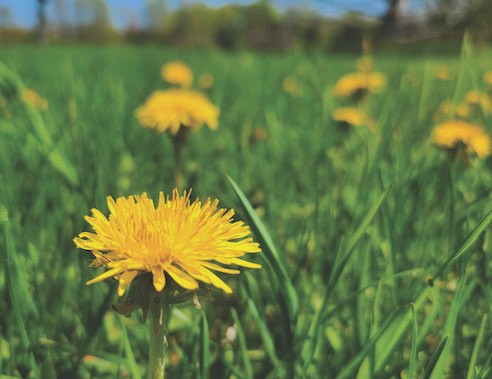How Green of a Lawn Do You Have to Have?
- Share
- Tweet
- Pin
- Share

Experts share ways to protect your well from above
We asked the Door County Conservationist if it’s possible for homeowners to accidentally poison their own wells.
Certainly, said Greg Coulthurst – and animal waste, fertilizers, leaked oil or pesticides can also travel away from your property to the neighbors’ wells.
The cracks are not straight that allow water to spill down through Door County’s fractured bedrock to aquifers. Sometimes the “zone of contribution” to a private well lies above a homeowner’s well, but some of the groundwater might come from the neighbor’s yard, or halfway down the block, Coulthurst said. Sometimes, much of the water stairsteps and zigzags its way to the well water from miles away.
With that in mind, Coulthurst, personally, doesn’t fertilize his lawn or spread pesticides and herbicides.
Dumping on your property, not picking up after pets, over-fertilizing, or indiscriminately spreading weed killer, are just “another way of chronically exposing yourself to something you shouldn’t be consuming.”
“How green of a lawn do you have to have?” Coulthurst said. “Do you have to have a Kentucky Bluegrass lawn, or is it OK to have a few dandelions?”
Expert Discusses Fertilizer Safety
While Coulthurst takes a purist view for his yard, not everyone does.
One of Wisconsin’s foremost experts on turfgrass, University of Wisconsin-Madison professor Paul Koch, said property owners should make sure they have “the right species of grass for the right situation.”
“One of the most problematic is Kentucky bluegrass,” Koch said, noting that in certain locations, no amount of fertilizer and water will cause Kentucky bluegrass to thrive.
Shady spots need shade grasses, and sunny, dry spots need grasses that can handle that. He said fine fescues are more shade-tolerant, need much less fertilizer and are more slow-growing but drought-tolerant than bluegrass.
“It’s not very traffic-tolerant,” he said, but added, “for a lot of people, fine fescues work quite well.”
Koch said it’s important to read the labels and properly set the spreader or sprayer to not dump excess product. It’s even more important, he said, not to fertilize grass that’s not growing.
“A lot of times fertilizer is put down too early,” Koch said, noting that the roots of the grass won’t take up all the nutrients if the ground hasn’t warmed and they’re not already growing.
Pre-emergent crabgrass preventers can be problematic, he said. Many of the granular products are incorporated with fertilizer, but traditionally people spread that between Easter and May. That’s when some of the fertilizer would go straight into the soil, he said. He also prefers pulling or spot-spraying weeds over granular products.
Koch suggests not fertilizing until Memorial Day, and then again in early July.
If people only fertilize once, the best time is September, when the ground’s warm and the roots should take up the nutrients to help the plants overwinter, Koch said. He prefers slow-release products that will slowly feed the grass.
If people are not using a spreader of the same brand as the product, they can take their square footage and calculate one pound of nitrogen for 1,000 square feet at a low-to-mid setting.
While some people think they can build up the soil profile with milorganite, raking in one-quarter inch of a quality compost can help improve poor soils.
In fall, leaving some of the last leaves of the season on the yard and mulching them up or running through them twice with the mower can provide great nutrients for lawns. Koch said if people mulch the leaves on the lawn, they should make sure it’s a thin enough layer that they can see the grass leaves coming through.
“If the soil is not conducive to grass, look at other plants that might do better,” he said.
Coulthurst concludes: “If the grasses don’t take up the nitrates, the nitrates go into your groundwater. If the grass and leaves don’t absorb 100% of the pesticide or herbicide, it goes into your groundwater.”
Protect the Groundwater from Your Property
•If you have an abandoned well and old pump on the property, has the well been filled and sealed? Otherwise it provides an easy pathway to groundwater pollution.
•Direct downspouts to your lawn, rain garden or rain barrel, away from pavement.
•Do not apply fertilizer or pesticides near sinkholes, fractures or wells in your yard. Build berms or grade your yard to direct water away from sinkholes, fractures and wells.
•Test your lawn’s soil to avoid over-applying fertilizer or providing nutrients that the soil already has. Testing is available through Door County UW-Extension or private firms.
•Have your septic system inspected and pumped every three years by a certified septic installer to be sure it functions properly.
•Properly dispose of household and hazardous waste (paint, drained oil, old fertilizers, herbicides, cleaning solutions, etc.) at collection sites and events.
•Test your well water each year. Water test kits are available from the Door County Sanitarian’s Department.
Source: Door County Soil and Water Conservation Department
Helpful Mowing Hint
Grass clippings of less than 1 inch in length left on lawns will filter down to the soil and decompose quickly, providing nutrients and reducing the need for nitrogen fertilizer. Remove longer clippings because they can shade or smother grass beneath, causing lawn damage.

